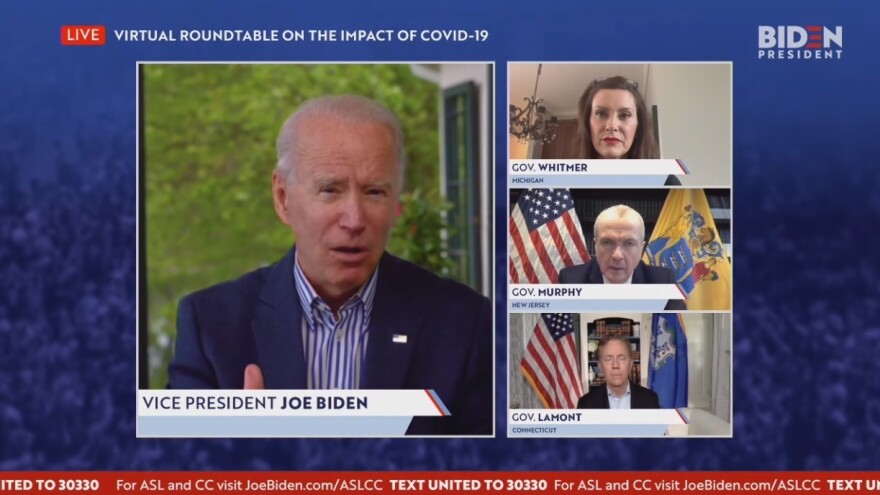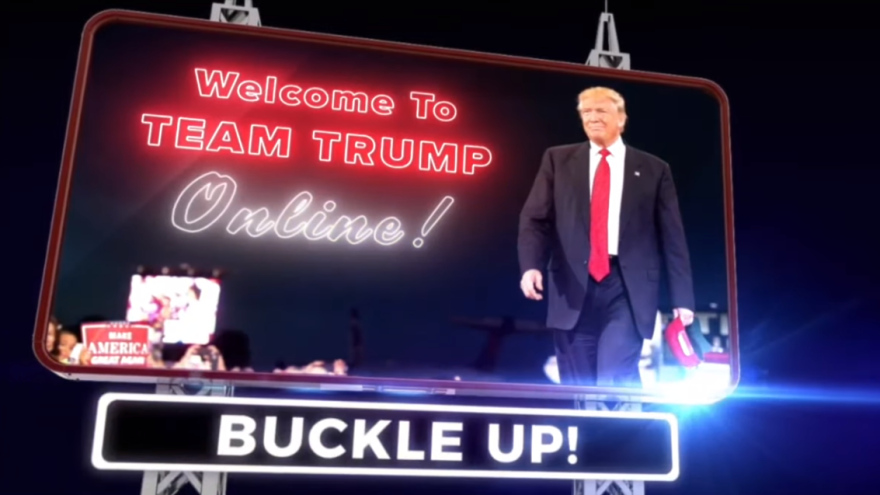If you're a supporter of President Trump, longing for the excitement and MAGA-kinship of a big rally, Trump's campaign has built the next best thing. It's a massive digital operation that creates an interactive world where Trump is flawless and Republicans are saviors, while Democrats and Joe Biden are wrong and dangerous.
They encourage supporters to "forget the mainstream media" and get their "facts straight from the source," an insular information ecosystem featuring prime time programming, accessed in its most pure form through the new Trump 2020 app.
Campaign manager Brad Parscale recently likened the Trump digital operation to the Death Star from the Star Wars movies.
Well, Biden's campaign is now comparing itself to the rebel alliance, the rag-tag crew fighting the Empire with whatever it could piece together.
All of this matters so much more because the coronavirus pandemic has brought traditional presidential campaigning to a standstill. Biden is stuck at home in Wilmington, Del., while Trump is deprived of his raucous rallies, so the battle for the presidency is now largely being waged over the Internet.
It's an arena where Biden is outmatched by his Republican opponent on a few levels. He doesn't have the social media dominance that Trump does. He also doesn't have Trump's instincts to entertain and outrage.
Instead, the presumptive Democratic nominee is trying to counter with a brand built on empathy and experience. And Biden's campaign is counting on the idea that it's what people want in a crisis, even if four decades as a senator and vice president don't necessarily prepare someone to create viral moments.
"The things that we're obviously trying to do in a virtual space are create those opportunities for interaction," said Biden digital director Rob Flaherty, "and sort of fill the void of leadership that we're seeing in Washington right now where the VP is an empathetic and competent leader in a time where people are craving both empathy and competence."
The Biden message is focused on the incredibly strong headwinds that Trump faces in his reelection bid: a pandemic and a deep recession. The president's campaign is counting on being able to overcome it all, at least in part with a digital behemoth that it has been building and perfecting since 2015. Parscale's elevation to campaign manager after being Trump's digital director in 2016 sent an early signal of what would drive the 2020 campaign.
The Biden campaign, on the other hand, has a digital presence that's admittedly still in development. It's looking outward to put him in as many places as possible and in front of as many people as possible.
That means Biden's team is organizing meetings over Zoom, conducting local TV interviews with anchors in battleground states, beaming the former vice president onto cable shows from his basement, and collaborating on Instagram with celebrities such as soccer star Megan Rapinoe, who may have a bigger following than the candidate.
"We really try to think about what is the broadest, widest array of creative programming that we can do to get him in front of people who are not necessarily dialed into politics day in and day out, but are looking at this crisis and feeling an incredible sense of uncertainty about what they're seeing from Trump," said Kate Bedingfield, Biden's communications director.
A prime-time president
Every night at 8 ET, you can tune in to a Team Trump webcast on Facebook, Twitter, YouTube and in the campaign's app, starting with a slick intro that's part campaign ad, part movie trailer, part cable news show open. Trump doesn't appear live, but glowing descriptions of him are a constant.
The programs are hosted by campaign aides and members of the Trump family with big name guests such as Texas Sen. Ted Cruz and Senate Majority Leader Mitch McConnell, who are teed up to amplify the Trump message.
"Why do Democrats insist on keeping people out of work, holding them hostage over ridiculous demands?" Lara Trump, the president's daughter-in-law, asked McConnell on a recent webcast.

It looks like cable news, but in reality it's more like an elaborate infomercial. Graphics in the lower third of the screen rotate through discount codes to buy Trump merchandise and prompts to download the Trump 2020 app or text the campaign.
There are multiple commercial breaks during each program that feature a mix of pro-Trump and anti-Biden campaign ads, information about how to volunteer and more reminders to download the app.
"The Democrats and the fake news media hate my father more than they love our country and they are doing whatever it takes to tear us down at the expense of the American people," Donald Trump Jr. says in one ad, speaking intensely. "That's why we need every American patriot to step up and join our fight. Just download our app."
A daytime Democrat
The Biden campaign doesn't have anything akin to its own version of a flashy prime-time cable lineup. Instead, in a given week it delivers a mix of virtual content: organizing meetings with former Democratic presidential candidates Beto O'Rourke and Pete Buttigieg, Zoom fundraisers with donors and virtual roundtables with Democratic governors to discuss COVID-19.
On a recent Thursday afternoon, Biden joined Democratic Govs. Gretchen Whitmer of Michigan, Ned Lamont of Connecticut and Phil Murphy of New Jersey to talk about their states' responses to the virus and what the federal government ought to do to help.

The events don't have the snazzy production value you see when tuning in to an evening of Trump campaign programming. Biden led the discussion from his patio at home in Wilmington with the sound of geese in the background.
These virtual events have some of the familiarity of a traditional Biden campaign event — intro music, periodic tangents ("Those Canadian geese are trying to get away from the virus," Biden jokes at one point.) and the turns of phrase that have long been dubbed "Bidenisms." For all those personal touches, they also lack the fundamental intimacy of in-person campaign events.
Still, both Biden and his campaign insist they're able to reach millions of people this way, brushing off the criticism that the Biden basement show is somehow hurting their campaign. For them, it's not just about how the message is delivered, it's about the message itself, convinced that the November election will be a referendum on how Trump has handled the coronavirus, and that gives them, they believe, an advantage.
And the critique of Trump's response is delivered consistently.
"The federal government should be having your backs and hasn't done it enough," Biden told the governors.
"He's been incompetent, the way in which he's responded to it," Biden recently said on ABC's Good Morning America, in yet another interview from his home studio.
Air Force One vs. local airwaves
Meanwhile, Trump has all the advantages of incumbency. His trademark rallies are gone for now, but with the White House testing everyone who could come near him for COVID-19, Trump can fly in Air Force One to swing states for official events that have all the contours of his rallies.
On a visit to a Pennsylvania manufacturer of protective equipment used by health care workers, the Trump campaign soundtrack played over the speakers and Trump's speech featured the usual jeering at the press in the back, the insults and name-calling.

Biden hasn't traveled anywhere for the last couple of months. Instead, he and his wife, Jill Biden, have begun "virtual travel days," where they host multiple events in one day in a key battleground state. On Wednesday, for example, Biden held a virtual roundtable "in" La Crosse, Wis., to discuss rural issues. Later in the day, he held a virtual rally in Milwaukee.
Throughout the primary season, voters often attended Biden rallies for the opportunity to shake the vice president's hand and take a photo with him on the rope line after he had finished a speech. That experience is hard to replicate digitally.
One major challenge of not holding in-person events is that a candidate is forfeiting valuable local news coverage, something Trump can pick up with his official travel.
"Most people don't go to those rallies," explained John Sides, a political science professor at Vanderbilt University. "But you're trying to use those events as an opportunity to get some attention to your campaign and to be able to communicate to voters with messages and visuals that are scripted by you, as opposed to posed to you by a reporter."
Local news is consistently considered one of the most trusted news sources across the political spectrum, and Biden's campaign has put a high premium on interviews in battleground states. Last week, he did interviews with stations in Nevada, North Carolina and Arizona.
Arizona has traditionally voted Republican, but the Biden campaign recently said it intends to target Arizona, along with a couple of other traditionally solid GOP states: Georgia and Texas.
Biden often beams into TV shows from his basement, flanked by books and family photos. His strategy is about emphasizing empathy and character and doing that in a way that can maximize reach.
Still, Biden is still largely stuck in his house, and he's often forced to explain that in these interviews.
"I'd much rather be out, but our governor has a shelter-in-place order here in the state. I'm obeying that order," Biden told KLAS-TV in Las Vegas.
He insists that he's listening to the scientists and that staying indoors while Trump is on the road hasn't changed the race. He points to polling that shows he has maintained a consistent lead over the president in recent weeks.
"Matter of fact, in a bizarre way, the president, the more he's out there the more he hurts himself, I think," Biden said in that same interview.
This is a view shared by many Democratic consultants, who say Trump's constant presence hasn't helped him in recent weeks.
"In a quest for content there is no way the Biden campaign is going to be able to produce as much as a reelection campaign and hyper politicized White House that turns official events into campaign stops," said Jesse Ferguson, who worked on Hillary Clinton's 2016 campaign. "The imbalance is real, for sure. But is it a problem? Not necessarily. One of the most pervasive emotions people feel about Trump is exhausted."
Organizing battleground neighbors
Even though Biden is not yet traveling to battleground states to campaign, his campaign is still trying to organize supporters in those key states. The campaign says it has trained thousands of volunteers over Zoom meetings in the past few weeks.
On a recent Zoom call, Gabriella Cascone, the Biden campaign's national training director, walked some 700 volunteers in Pennsylvania through the process of making community check-in calls. The campaign's current phone banking strategy is not about attacking Trump or getting out the vote, it's about being a comforting neighbor in a moment of crisis.
"Really, these are meant to be a way to let folks know that we care about them and we're thinking about them in this time," Cascone told volunteers over the call. "It's important that we follow the vice president's lead in demonstrating this deep empathy and concern toward our supporters."
That was the approach taken by the Trump campaign and Republican National Committee a month and a half ago. But wellness checks have been replaced with scorched-earth scripts meant to cause maximum harm to Biden's image.
Last Tuesday, Joe Vazzano, a Republican regional field director in Southwestern Pennsylvania, used Zoom to walk about 100 Trump campaign volunteers in his area through the process of making calls to voters.
Thank you @reschenthaler for joining us for our virtual training tonight! #LeadRight #TeamPA pic.twitter.com/ijt0zhOCkN
— Joe Vazzano (@Joe_Vazzano) May 12, 2020
It was a "national week of action," which meant there was an extra push to train volunteers and get them working the phones. The aim is to beat up Biden, tie him to China and paint him as an establishment figure with conflicts of interest because of his son Hunter's business activity.
The scripts the volunteers were given to read when calling voters included lines like "Beijing Biden promoted trade deals that killed American jobs and shipped them overseas to China" and "Beijing Biden's relationship with China benefited his family. His son Hunter was involved in a business deal with a Chinese investment fund." This dovetailed with ads the Trump campaign was running on television stations in the same swing states the volunteers were calling.
Over the course of the week, the Republican Party, which is fully integrated with the Trump campaign, held about 500 training sessions like that one. Volunteers and staff organizers made 10 million calls, a record according to the RNC. The Biden campaign did not provide metrics for an equivalent time frame.
Social media reach
According to the Facebook Ad Library, the Trump campaign spent more than twice as much last week on Facebook ads as the Biden campaign, and it included a three-day test of a dizzying array of hits on Biden. Some portrayed him as old and unfit, others as a puppet of China.
"One of the greatest strengths President Trump has is taking someone's perceived greatest strength and turning it into a weakness," said Jason Miller, who was senior communications adviser on the 2016 campaign. He said that in the face of the coronavirus, the Trump campaign is "controlling the variable it can control for — going negative on Biden."
Teddy Goff, a Democratic strategist who ran Barack Obama's 2012 digital operation, concedes that Trump is incredibly talented at capturing attention, but he's skeptical that the president's virtual programming is actually reaching the right kinds of people for a general election.
"Donald Trump can send a berserk tweet that kind of ping-pongs around the right-wing Twittersphere and gets 50,000 retweets, and it probably doesn't persuade a single voter," he said. "And it might actually turn off a couple of voters."
The Trump campaign isn't really doing persuasion. It's firing up the base, finding supporters who didn't vote last time and getting them to vote this time.
"This is about protecting your voters from anything that might, maybe not persuade them to vote for someone else, but might keep them from turning out," said Stefan Smith, who was the online engagement director for Buttigieg's presidential campaign and has spent a lot of time looking at the Trump app and the Team Trump video offerings. "Keep them angry and you keep them engaged," he added.
On his own Facebook page, Trump has more than 29 million followers. Fewer than 2 million follow Joe Biden. Twitter tells a similar story: about 80 million for Trump, 5.4 million for Biden.
The Biden campaign barely made any digital hires for months, but Flaherty says they have plans to double its staff soon, though he wouldn't provide any specific staffing numbers.
Since the Biden campaign went mostly virtual in late March, it has had more than 125 million views of its videos and online content, while Trump's campaign has had nearly three times as many views since April 1, according to numbers provided by the campaigns.
The Biden team argues that since their candidate has millions fewer followers, in some ways he's actually punching above his weight.
Copyright 2021 NPR. To see more, visit https://www.npr.org.




